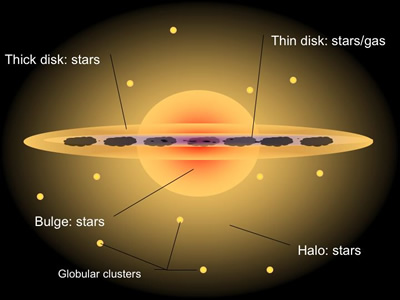Thick Disk

Many spiral galaxies have been shown to exhibit disks that are composed of two kinematically and chemically distinct populations. The narrower of the two disks (the thin disk) contains dust and gas as well as stars, while the broader ‘thick disk’ is entirely stellar.
Thick disks are believed to exist in some, but not all disk galaxies. Whether this is actually the case is not completely resolved, nor is it clear whether the thick disk of the Milky Way is typical of thick disks in other spiral galaxies.
Not surprisingly, the first thick disk discovered was that of our own Galaxy, the Milky Way. First noticed in star counts, the thick disk contains about 10% of the stellar mass of the Milky Way and has a scale height of ~ 1,000 light years (the thin disk has a scale height of only ~ 400 light years). The greater scale height of the thick disk is the result of it being ‘kinematically hotter’ than the thin disk. This means that thick disk stars are, on average, moving ~20 km/sec faster in a vertical direction with respect to the galactic plane than thin disk stars. This is independent of the fact that thick disk stars rotate about the Galactic centre slower than the thin disk stars by about 40 km/sec.
Apart from being kinematically distinct, the thick and thin disks also differ in their stellar populations. Thin disks contain young stars, while the stars in thick disks are almost all older than 10 billion years. The metallicities of thick disk stars range from about 1/10 to 1/2 that of the Sun, with a typical value of around 1/4 solar. For comparison, metallicities in the thin disk range from 1/3 to 3 times that of the Sun. Both the differing age and chemical properties of the stellar populations suggests that the formation scenarios for the thin and thick disks were different. In particular, it is thought that the thick disk formed early in the Galaxy’s history and then ceased all star formation. The thin disk, however, started forming later and continues to form stars to this day.
The actual formation mechanism of the Galactic thick disk is something of an enigma. It has been suggested that it may have formed as the result of a significant merger event early in the Galaxy’s history. If this is the case, the event must have taken place before the thin disk had fully formed, as both observations and N-body modelling indicate such events disrupt the disk and consume a significant fraction of the cold gas in a burst of new star formation. The presence of a substantial, uniform disk in modern times therefore indicates that any major merger must have taken place long ago.
An alternative to the major merger scenario is one in which the thick disk formed relatively slowly by the actions of multiple minor mergers. The gas would collapse back into the galactic plane forming a thin disk, while the stars would retain the larger scale height of a thick disk. The Milky Way is currently subject to at least two minor mergers, with the Sagittarius and Canis Major dwarf galaxies, suggesting that this could be a real possibility. However, the lack of young stars in the thick disk would again suggest that such processes must have stopped, or at least significantly slowed, a long time ago.
Other, non-merger, models have also been put forward for the formation of thick disks, including secular evolution heating processes and various forms of the primordial collapse model, fine-tuned to produce a thick disk. These models are not currently favoured, as they all have difficulty predicting the observed properties of the thick disk.
Study Astronomy Online at Swinburne University
All material is © Swinburne University of Technology except where indicated.

